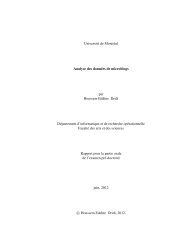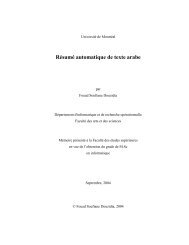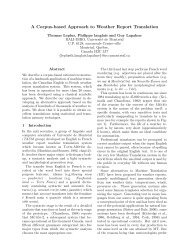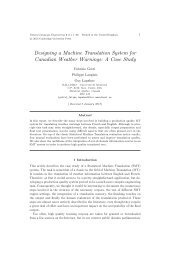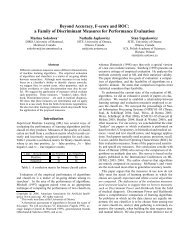TT2 flyer (PDF 100K) - RALI - Université de Montréal
TT2 flyer (PDF 100K) - RALI - Université de Montréal
TT2 flyer (PDF 100K) - RALI - Université de Montréal
Create successful ePaper yourself
Turn your PDF publications into a flip-book with our unique Google optimized e-Paper software.
Consortium Partners<br />
For more information<br />
Ordinary mail:<br />
José Esteban Lauzán<br />
Atos Origin<br />
Albarracín 25<br />
28037 Madrid, Spain<br />
Phone: +34 91 214 8613<br />
Fax: +34 91 754 3252<br />
Email:<br />
jfernando.esteban@atosorigin.com<br />
Web site: http://tt2.sema.es<br />
http://www.atosorigin.com/<br />
http://www.rwth-aachen.<strong>de</strong>/<br />
http://www.iti.upv.es/<br />
INSTITUTO TECNOLOGICO<br />
DE INFORMATICA<br />
UNIVERSIDAD POLITÉCNICA<br />
DE VALENCIA<br />
RECHERCHE APPLIQUÉE EN<br />
LINGUISTIQUE<br />
INFORMATIQUE<br />
UNIVERSITÉ DE MONTRÉAL<br />
http://www-rali.iro.umontreal.ca/<br />
TransType2<br />
Computer Assisted Translation<br />
http://www.celersol.com/<br />
tt2.sema.es<br />
http://www.societe-gamma.com/<br />
IST-2001-32091<br />
http://www.xrce.xerox.com/
Project summary<br />
Funding: Fifth Framework Programme, IST<br />
Programme. In Canada, by the<br />
International Cooperative Research and<br />
Development grant, NSERC - Canada<br />
and MDER - Québec<br />
Action Line: III.3.2 Natural and multilingual<br />
interactivity<br />
Duration: 36 months (March 2002 – February<br />
2005)<br />
Main themes: Interactive MT, Computer Ai<strong>de</strong>d<br />
MT<br />
Languages: English, French, German and<br />
Spanish<br />
Goals<br />
The main objectives of <strong>TT2</strong> are two-fold:<br />
1. To provi<strong>de</strong> a framework in which leadingedge<br />
research can be conducted in the area<br />
of data driven methods in natural language<br />
processing and, more specifically, translation.<br />
2. To <strong>de</strong>velop a practical application for that<br />
research which will help to solve a pressing<br />
social problem: how to meet the ever-growing<br />
<strong>de</strong>mand for high-quality translation.<br />
The research conducted in our project is applied<br />
to the <strong>de</strong>velopment of an innovative, interactive<br />
machine translation system. <strong>TT2</strong> facilitates the<br />
task of producing high-quality translations and<br />
making the translation task more cost-effective<br />
for human translators.<br />
The <strong>TT2</strong> prototype comprises six translation<br />
pairs: English ↔ Spanish, English ↔ French<br />
and English ↔ German.<br />
Context<br />
There is common agreement within the scientific<br />
community in distinguishing two major<br />
paradigms in the area of translation automation:<br />
1. The Machine Translation paradigm<br />
2. The Computer Assisted Translation paradigm<br />
Both paradigms revolve around the i<strong>de</strong>a of how<br />
the translator and the computer interact during<br />
the translation process.<br />
Machine Translation systems aim at producing<br />
full translations, hence performing the function of<br />
the translator (i.e. replacing him or her). On the<br />
other hand, the CAT paradigm aims at using the<br />
computer to help the translator to produce better<br />
translations more efficiently.<br />
<strong>TT2</strong> can be <strong>de</strong>scribed as an optimal combination<br />
of both paradigms, as it keeps the translator in<br />
control of the process and lets the machine<br />
provi<strong>de</strong> suggestions via a data driven MT<br />
engine.<br />
Approach<br />
The <strong>TT2</strong> approach proposes translation<br />
completions while the translator creates the<br />
target text. This approach acknowledges two<br />
basic facts:<br />
1. Human translators are key to guaranteeing<br />
high quality output<br />
2. Machines are key to speeding up the<br />
translation process and making it more<br />
efficient<br />
Starting points<br />
The results of two previous projects served as<br />
a starting point: TransType and EuTrans.<br />
TransType (<strong>RALI</strong> Laboratory) <strong>de</strong>veloped a tool<br />
for speeding up and facilitating the work of<br />
translators by automatically suggesting<br />
translation completions. The system revises its<br />
calculations and provi<strong>de</strong>s new suggestions that<br />
are compatible with each translator's new<br />
input. The prototype was trained with the<br />
Canadian Hansard corpus for English to<br />
French translations.<br />
EuTrans (ITI and RWTH) focused on the<br />
<strong>de</strong>velopment of novel approaches for speech<br />
and text automated translation-using data<br />
driven methods:<br />
Finite-state automata language mo<strong>de</strong>ling<br />
Application to written and spoken translation<br />
in limited domains<br />
Foreseen advances<br />
<strong>TT2</strong> combines different techniques:<br />
Probabilistic mo<strong>de</strong>ls<br />
Finite-state automata<br />
Incorporation of <strong>de</strong>clarative linguistic<br />
knowledge<br />
Prediction of translation completions is<br />
improved in two main aspects:<br />
Higher accuracy<br />
Larger completions (phrases, full sentences)<br />
Productivity and usability is also evaluated in<br />
real working conditions with the incorporation<br />
of a speech modality.




